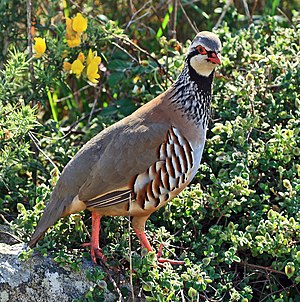Red chicken
| Red chicken | ||||||||||
|---|---|---|---|---|---|---|---|---|---|---|

Red-legged partridge ( Alectoris rufa ) |
||||||||||
| Systematics | ||||||||||
|
||||||||||
| Scientific name | ||||||||||
| Alectoris rufa | ||||||||||
| ( Linnaeus , 1758) |
The red-legged partridge ( Alectoris rufa ) is a bird art from the family of pheasant-like (Phasianidae) used to order the chicken birds heard (Galliformes).
Appearance
The red partridge is very similar to the stone partridge . Unlike this, however, it is brownish and not gray feathered on the top of the head and back. The white throat patch is smaller. The chest band that delimits the throat patch is not as clearly separated on the belly as in the stone fowl. It runs up in a black spot. The bright red tail feathers are also visible in the flight of red chickens.
The red partridge has a number of calls that generally have a social function. The Chechen or tset psiä tok ... shouts can repeat long lasting. Males perform their song, which can be heard from a few hundred meters away, from a control room or from the ground. The singing begins with a sharp wät-wät and slowly increases with tek-tek or tok tok . The highlight of the call are combinations of tok elements with crow sounds. A characteristic sequence of calls is a tok-tok-korährähräh-korähräh .
distribution and habitat
The red partridge can now be found in the Iberian Peninsula, in southern France and in north-western Italy. In France, the distribution is limited to the north by the 8 ° C March isotherm and to the east by the 2 ° C January isotherm. It was also naturalized in the Azores , Gran Canaria , Madeira , the Balearic Islands , Corsica and New Zealand . The red-legged partridge was released into the wild in Great Britain around 1770 and has been a valued game in southern and central England ever since. After chukar chickens were also released there, however, hybridization with the red chickens living there occurred. In Great Britain, therefore, the release of chukar chickens and mixed breeds between red and chukar chickens has been banned since September 1992. The red grouse was also found in the Rhine , Aar and Neckar valleys until the 16th century . It disappeared around 1560 when the climate deteriorated. The last occurrences in Bavaria lasted until the 18th century, in the canton of Jura until the 19th century. The last Central European breeding occurrences were in the south of Switzerland, but they died out by 1920. There have been a number of attempts to settle in Central Europe, but most of them have failed. Newly established breeding populations in the Netherlands, which comprised 25 to 30 breeding pairs in the 1980s, have been extinguished again. Between 1998 and 2000, however, three to ten breeding pairs were established in the south of the Netherlands, and there were individual broods in North Rhine-Westphalia in the 1990s and one brood in Bavaria in 2000.
Three subspecies are distinguished within its range.
The red grouse occurs in its southern distribution area up to altitudes of 2000 meters, but prefers flat to undulating terrain on light soils as a habitat.
supporting documents
literature
- Hans-Günther Bauer, Einhard Bezzel and Wolfgang Fiedler (eds.): The compendium of birds in Central Europe: Everything about biology, endangerment and protection. Volume 1: Nonpasseriformes - non-sparrow birds. Aula-Verlag Wiebelsheim, Wiesbaden 2005, ISBN 3-89104-647-2 .
- Heinz-Sigurd Raethel : quail, partridge, stone fowl, francoline and relatives. Reutlingen publishing house, Reutlingen 1996, ISBN 3-88627-155-2 .
Web links
- Alectoris rufa in the endangered Red List species the IUCN 2008. Posted by: BirdLife International, 2008. Accessed January 31 of 2009.
- Videos, photos and sound recordings on Alectoris rufa in the Internet Bird Collection
- Age and gender characteristics (PDF; 4.3 MB) by J. Blasco-Zumeta and G.-M. Heinze (English)
- Feathers of the red partridge
Individual evidence
- ^ Hans-Heiner Bergmann, Hans-Wolfgang Helb, Sabine Baumann: The voices of the birds of Europe - 474 bird portraits with 914 calls and chants on 2,200 sonograms. Aula-Verlag, Wiesbaden 2008, ISBN 978-3-89104-710-1 , p. 77. This source has been used for the onomatopoeic description of the voices.
- ↑ a b Bauer et al., P. 152
